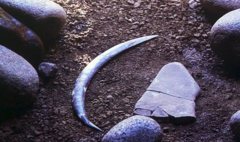An exceptional archaeological find in Poland, revealing a 40,000-year-old boomerang, challenges previous assumptions about early human tool-making capabilities.
Ancient Craftsmanship Revealed: The World's Oldest Boomerang Unveiled

Ancient Craftsmanship Revealed: The World's Oldest Boomerang Unveiled
Researchers discover that the oldest boomerang, dated at 40,000 years, showcases early human ingenuity in Poland.
The world’s oldest boomerang has been unearthed, offering profound insights into the sophistication of prehistoric humanity. Discovered in 1985 in Oblazowa Cave, Southern Poland, recent studies reveal that this incredible tool is around 40,000 years old, significantly older than the initially estimated 30,000 years.
Crafted from mammoth tusk, this artifact demonstrates remarkable skill in its design, indicating it was aerodynamically crafted for flight but was not intended to return to the thrower. Experts suggest its primary use was likely hunting, though it may have also held cultural significance or functioned in rituals.
Dr. Sahra Talamo from the University of Bologna emphasizes that the boomerang, the only one of its kind found in Poland, offers unique insights into how Homo sapiens utilized their environment and crafted functional tools. The exceptional preservation of this ivory artifact features polishing and carving marks, hinting that it was made for right-handed use.
Contrary to the common association of boomerangs with Aboriginal culture in Australia, findings like this suggest that similar tools had a broader historical presence across various continents. The well-known Australian boomerangs date back approximately 10,500 years, while remarkably, the earliest representations of these tools can be traced back to rock art dating around 20,000 years ago. In European contexts, evidence of boomerang use has been found in Jutland (7,000 years old) and the Netherlands (2,000 years old).
The collaborative research, which involved scientists from Poland, Italy, Germany, France, Switzerland, and the UK, has been published in the journal PLOS One, marking a significant contribution to our understanding of ancient human innovation.




















